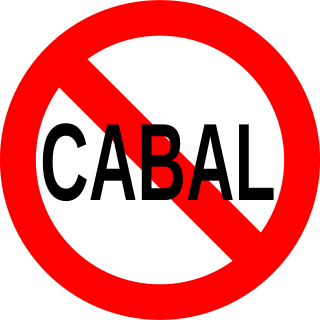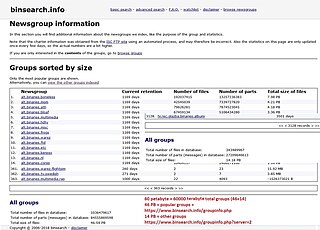Related Research Articles
A Usenet newsgroup is a repository usually within the Usenet system, for messages posted from users in different locations using the Internet. They are discussion groups and are not devoted to publishing news. Newsgroups are technically distinct from, but functionally similar to, discussion forums on the World Wide Web. Newsreader software is used to read the content of newsgroups.

There Is No Cabal is a catchphrase and running joke found on Usenet. The journalist Wendy M. Grossman writes that its appearance on the alt.usenet.cabal FAQ reflects conspiracy accusations as old as the Internet itself. The anthropologist Gabriella Coleman writes that the joke reveals "discomfort over the potential for corruption by meritocratic leaders".
The Great Renaming was a restructuring of Usenet newsgroups that took place in 1987. B News maintainer and UUNET founder Rick Adams is generally considered to be the initiator of the Renaming.
news.admin.net-abuse.email is a Usenet newsgroup devoted to discussion of the abuse of email systems, specifically through email spam and similar attacks. According to a timeline compiled by Keith Lynch, news.admin.net-abuse.email was the first widely available electronic forum for discussing spam.

A news server is a collection of software used to handle Usenet articles. It may also refer to a computer itself which is primarily or solely used for handling Usenet. Access to Usenet is only available through news server providers.
The Network News Transfer Protocol (NNTP) is an application protocol used for transporting Usenet news articles (netnews) between news servers, and for reading/posting articles by the end user client applications. Brian Kantor of the University of California, San Diego, and Phil Lapsley of the University of California, Berkeley, wrote RFC 977, the specification for the Network News Transfer Protocol, in March 1986. Other contributors included Stan O. Barber from the Baylor College of Medicine and Erik Fair of Apple Computer.

The alt.* hierarchy is a major class of newsgroups in Usenet, containing all newsgroups whose name begins with "alt.", organized hierarchically. The alt.* hierarchy is not confined to newsgroups of any specific subject or type, although in practice more formally organized groups tend not to occur in alt.*. The alt.* hierarchy was created by John Gilmore and Brian Reid.

B News was a Usenet news server developed at the University of California, Berkeley by Matt Glickman and Mary Ann Horton as a replacement for A News. It was used on Unix systems from 1981 into the 1990s and is the reference implementation for the de facto Usenet standard described in RFC 850 and RFC 1036. Releases from 2.10.2 were maintained by UUNET founder Rick Adams.
Newsgroup spam is a type of spam where the targets are Usenet newsgroups.
When a message is replied to in e-mail, Internet forums, or Usenet, the original can often be included, or "quoted", in a variety of different posting styles.

Mary Ann Horton, is a Usenet and Internet pioneer. Horton contributed to Berkeley UNIX (BSD), including the vi editor and terminfo database, created the first email binary attachment tool uuencode, and led the growth of Usenet in the 1980s.
Forté Agent is an email and Usenet news client used on the Windows operating system. Agent was conceived, designed and developed by Mark Sidell and the team at Forté Internet Software in 1994 to address the need for an online/offline newsreader which capitalized on the emerging Windows GUI framework. By 1995, Agent had expanded to become a full-featured email client and remains a widely used application for integrating news and email communication on Windows. Agent supports POP email but not IMAP.
The Breidbart Index, developed by Seth Breidbart, is the most significant cancel index in Usenet.

A newsreader is an application program that reads articles on Usenet distributed throughout newsgroups. Newsreaders act as clients which connect to a news server, via the Network News Transfer Protocol (NNTP), to download articles and post new articles. In addition to text-based articles, Usenet is also used to distribute binary files, generally in dedicated "binaries" newsgroups.

Eugene Howard Spafford, known as Spaf, is an American professor of computer science at Purdue University and a computer security expert.
The Lumber Cartel was a facetious conspiracy theory popularized on USENET that claimed anti-spammers were secretly paid agents of lumber companies.
Rich Rosen is a software developer and an author on the subject of web development, who gained notoriety as an early high-volume contributor to Usenet newsgroups.
A Usenet personality was a particular kind of Internet celebrity, being an individual who gained a certain level of notoriety from posting on Usenet, a global network of computer users with a vast array of topics for discussion. The platform is usually anonymous, although users can get celebrity status, usually by being deemed different from other posters in some way.

Usenet, USENET, or "in full", User's Network, is a worldwide distributed discussion system available on computers. It was developed from the general-purpose Unix-to-Unix Copy (UUCP) dial-up network architecture. Tom Truscott and Jim Ellis conceived the idea in 1979, and it was established in 1980. Users read and post messages to one or more topic categories, known as newsgroups. Usenet resembles a bulletin board system (BBS) in many respects and is the precursor to the Internet forums that have become widely used. Discussions are threaded, as with web forums and BBSes, though posts are stored on the server sequentially.
References
- ↑ "Modern Usenet Newsgroup Hierarchies History". BroadbandNow. Retrieved 2020-10-26.
- ↑ Usenet posting: "backbone sites needed", by Mark (now Mary Ann) Horton, 15 February 1983
- ↑ Usenet posting: "proposed USENET backbone", by Mark (now Mary Ann) Horton, 21 March 1983
- ↑ Usenet History email: "Usenet backbone", by Gene Spafford, 17 October 1990
- ↑ "TINC". The Jargon File . Retrieved August 15, 2020.
- ↑ "backbone cabal". TechWeb. Archived from the original on 2007-09-27. Retrieved 2007-09-07.